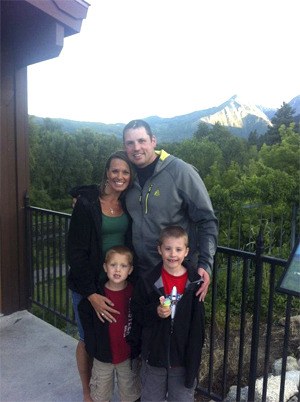
Courtesy photos
Months after surgery, David Heyling was able to enjoy some of his outdoor activities, but his hair growth still highlights the surgical scar.

When David Heyting had a grand mal seizure last November, he was embarrassed.
Meeting a potential business client “at a UW Starbucks, so it was a packed house,” Heyting said he had no memory of what actually happened. He just fell to the floor unconscious, in a violent fit of muscle spasms.
Days later, the healthy, active 34-year-old Snoqualmie man met with a neurologist, and was somewhat reassured.
“They give everybody one seizure in their lifetime,” Heyting explained.
Sometimes a healthy person will seize—once—for no apparent reason, the neurologist told him. As a rule, those seizures almost never re-occur, but just to be safe, the doctor ordered an MRI of his brain.
Heyting was an exception to the rule. He had least three more seizures in the next two weeks.
He also had surgery to remove a tennis-ball-sized tumor from the right side of his brain, exactly two weeks after that first seizure he had in Starbucks.
He hasn’t had a seizure since then, but he takes anti-seizure medicine, and is nearly done with a year-long course of chemotherapy. He has his wife, Jessica, and two sons, Colby, 7, and Cade, 5, his job as a CPA, and brain cancer.
It’s why he’s walking this Saturday, Sept. 22 in the Seattle Brain Cancer Walk at Seattle Center (www.braincancerwalk.org), and why he is hoping to raise $25,000 from the event.
“It kind of changes your point of view a little bit… it’s something that I’m going to have forever,” Heyting said.
Part of the tumor, which his sister named Goliath, is still inside his brain. It sits in the area of the brain that controls motor functions on the left side of his body, and his emotions.
“They couldn’t take it all out, without leaving me with … some type of damage issues,” Heyting said.
As it was, the surgery did affect his left side, and he took several weeks to regain full use of his left hand, he said. It could have been much worse.
“That was one of the fears going in, I could have this surgery and still end up partially paralyzed,” he said, or he could have lost his job. “I’m a CPA, so basically I’m only as good as my mind is.”
About a month after surgery, he was recovered enough to go back to work, but he’d already been working several weeks at his second “job,” writing for a blog that his sister Kerri created for him.
Originally, she set it up for him to post updates on his condition for family and friends to read, Heyting said, but “It’s been kind of a fun thing, and therapeutic to get my thoughts out.”
With thousands of visitors and more than 100 subscribers, David’s Blog (http://davidheyting.wordpress.com) has also become a vehicle for promoting Heyting’s non-profit, Defeat Goliath. The mission of Defeat Goliath is to fund brain tumor research, which has proved so valuable to Heyting already.
Because of advanced cancer research conducted in the Northwest, Heyting had better information about his tumor than most people probably get.
“I’m kind of lucky to be in the Seattle area, because there are advanced centers, with people doing really cool things,” he explained, like the genetic testing done on his tumor. The results of that showed that chemotherapy would be a more effective treatment, he said, “but a lot of places don’t do that type of testing.”
His chemotherapy is a five-day course of pills, taken once a month. The drugs sap his strength and energy, forcing him to miss about one week of work each month, and miss out on all the running, hiking, and climbing that he used to do with his family.
“We’re big outdoor folks,” he said, and that “we” includes his two young boys. They do everything their parents do, and sometimes, a lot more than Dad is up for these days.
“I’m just tired constantly, and that’s been a real struggle for me,” Heyting said. “There’s just certain things I can’t do when I’m on a (chemotherapy) cycle… and they want to play. That’s been one of the harder parts for me, is having to tell them no.”
He has talked to his boys about his cancer, and wants to keep them involved in the process as much as he can. They are the main reason he is on this particular treatment, he says.
“If you have one year to actually live, you want to make sure that, if you’re doing treatment, it’s the best treatment for you.” he said.
Many brain tumors are fatal within one to two years, he said, which is much too little time. Even his own prognosis is too short.
“Most people have about a 12-year lifespan, with the type of tumor I have,” he said. “I just hope that maybe I’m different.”
To contribute to David’s team, visit community.swedish.org or go to the Defeat Goliath Foundation website, http://defeatgoliath.org.


